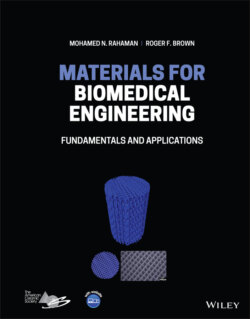Читать книгу Materials for Biomedical Engineering - Mohamed N. Rahaman - Страница 28
1.4.2 Intrinsic Properties of Ceramics
ОглавлениеExcept for carbon, ceramics are compounds of metallic and nonmetallic elements, such as Al2O3 or silicon nitride (Si3N4 ), for example. Although ceramics used in technological or engineering applications typically show better strength and elastic modulus than most metals, a distinctive drawback is their inherent brittleness. Brittleness refers to the catastrophic shattering of an object into two or more pieces under sufficiently high mechanical stresses. Despite their brittleness, ceramics can be engineered to function safely and reliably over long durations under high stresses if these stresses are compressive in nature. Ceramics are not recommended for use in high‐stress applications when the applied stress has an appreciable tensile or bending component. In general, ceramics show high hardness and wear resistance.
The density of ceramics is lower than that of most metals, often by a factor of two or more, which means that for the same geometry, a ceramic implant will not be as heavy as a metal implant. Ceramics are generally poor conductors of electricity and heat, and those ceramics used in technological applications normally have a high degree of chemical inertness. On the other hand, certain compositions, such as hydroxyapatite and β‐tricalcium phosphate, composed of the same ions as the mineral constituent of bone, show some reactivity in the physiological environment.
Ceramics are generally more difficult to fabricate than metals and far more difficult to fabricate than polymers. Forming ceramics into useful objects having the requisite external shape and microstructure often requires high fabrication temperatures, approximately several hundred degrees Celsius. Due to their high hardness, ceramics are expensive and difficult to machine into the desired shape and surface smoothness after their fabrication.
Overall, major limitations of ceramics are their brittleness, and the difficulty and cost of fabricating them into useful objects. On the other hand, ceramics have high compressive strength, stiffness, hardness, and wear resistance. Consequently, ceramics generally find use in applications where the applied stress is much lower than their strength or mainly compressive in nature, and where high wear resistance and chemical inertness are required.
